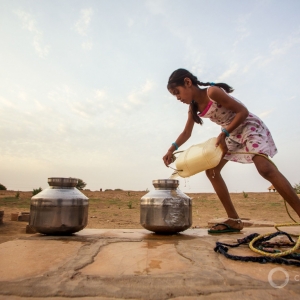The Stream, January 18, 2023: The Killing of Two Water Defenders in Honduras Prompts Calls for Justice

Mourners hold a vigil outside the Organization of American States for Berta Cáceres, who was murdered in Honduras on March 3, 2016 for opposing a dam project. Photo courtesy Daniel Cima / Comisión Interamericana de Derechos Humanos via Flickr Creative Commons
YOUR GLOBAL RUNDOWN
- Two water defenders, protesting an open-pit iron oxide mine in Carlos Escaleras National Park, are killed in Honduras.
- On the Xingu River in Brazil, Indigenous communities oppose a proposed gold mine.
- A new map shows the number of shared groundwater basins along the U.S.-Mexico border is much higher than the two countries officially recognize.
- In South Africa, rolling power outages and dwindling water supplies spur protests and calls for rationing.
Elevated levels of chloride in the Mississippi River have sparked a road salt reckoning in the Midwestern U.S.
“There’s pretty good evidence that if we continue to use salt at the rate we do now, it’s going to be detrimental to the rivers and lakes eventually. We need to do something about it now.” — Ryan Westphal, facilities director at the La Crosse County Facilities Department.
Road salt, used to de-ice and de-snow pavement, has been a staple of Midwestern winters for decades. But a growing body of research has shown that the material — which in the past was used generously and often on city and county roads — has been relentlessly washing into freshwater streams and rivers. Between 1989 and 2018, chloride levels in the Mississippi River’s upper basin have increased by at least 35 percent, the Milwaukee Journal Sentinel reports. In other stretches of Midwestern rivers, including in Wisconsin and Minnesota, this increase has been measured as high as 60 percent.
Chloride is a detrimental mineral in freshwater environments, the Sentinel reports. It destabilizes ecosystems by salinating the water, killing plants and plankton, and corroding pipes and sanitation infrastructure. Each impact gives rise to further events, such as an increase in harmful algal blooms.
Aware of these effects, municipalities are engineering new approaches with their road salt: Applying it more conservatively, using brine instead, and enrolling workers in Smart Salt training. According to the Sentinel, communication and education have been key tools in working toward not-so-salty solutions.
— Christian Thorsberg, Interim Stream Editor
Recent WaterNews from Circle of Blue
- Federal Government Advances Big Water Projects — Congress focuses on flood protection and disaster recovery.
- New Mexico Town, Still Reeling from Historic Fire, Receives Federal Aid to Repair Drinking Water System — The town of Las Vegas is eligible for up to $140 million for drinking water treatment facilities.
The Lead
In Honduras, one of the world’s deadliest countries for environmental activists, two water defenders were killed in broad daylight earlier this month, Al Jazeera and WBUR report. Aly Dominguez, 38, and Jairo Bonilla, 28, had been organizing and leading peaceful protests since 2018 — including an 11-day occupation of a mayor’s office, and blocking a road for transporting construction equipment — in opposition of an open-pit iron oxide mine operating in Carlos Escaleras National Park. Activists and independent organizations have said that the mine was approved under dubious legal circumstances, and pollutes the park’s rivers, which farmers and fishers depend on.
Dominguez and Bonilla, beloved in their community of Guapinol, were the co-founders of the Guapinol Water Defenders movement. International activists are calling for transparency and action from Honduran president Xiomara Castro, who said last year that she would end the violence against environmental activists and cancel open-pit mining permits, Al Jazeera reports.
Last week, a United Nations special rapporteur called for an independent investigation into the deaths.
This Week’s Top Water Stories, Told In Numbers
11
The number of groundwater aquifers the United States and Mexico officially share along their border. But, furthering similar research from 2021, a recently-released map — made by Rosario Sánchez from the Texas Water Resources Institute, and Laura Rodríguez from Texas A&M University — updates this count to 72, nearly half of which are in “good to moderate” condition, High Country News reports. A lack of consensus over what qualifies as an aquifer has made regulating these transboundary waters nearly impossible. The map, which offers perhaps the most thorough look yet at these shared water systems, works to bridge the discrepancies.
15 percent
Combined water level of the Impofu and Churchill dams outside Gqeberha, South Africa, GroundUp reports. Across the country, water supplies have been inconsistent in recent months, especially in rural areas, a result of rolling blackouts. Gqeberha, a southern coastal city, has been especially beset by drought. It is on “Day Zero” watch, prompting local officials to issue water restriction notices. In the north, in the town of Kroonstad, hundreds of protestors marched on Monday, demanding better infrastructure and consistent access to water, which residents say they haven’t received in over 20 years.
On the Radar
Mongabay reports that Belo Sun, a Canadian mining company, is eyeing the Xingu River in the Brazilian Amazon as the location for a proposed gold mine. The site, a unique “big bend” in the river, is an important ecological watershed and the home to multiple Indigenous communities. Upriver, the existing Belo Monte dam already diverts 85 percent of the Xingu’s flow, which has decimated the communities’ ability to fish, Mongabay reports. The communities are continuing to resist Belo Sun’s arrival, and tensions are running high. Those who have been outspoken in opposition to the mine have received threats, and some have been met with physical violence.
More Water News
Irrawaddy Dolphin: Radio Free Asia reports that an uptick in dolphin deaths in Bangladesh has the environmental community concerned over the future of the endangered species, which lives in both brackish and fresh waters.
Climate Change and Diarrhea: Grist reports on a new study from the Proceedings of the National Academy of Sciences, which links “precipitation shocks” — droughts, floods, and other strong, intensely wet or dry weather events — with an increased incidence of diarrheal diseases among young children in many parts of the world.
Christian Thorsberg is an environmental writer from Chicago. He is passionate about climate and cultural phenomena that often appear slow or invisible, and he examines these themes in his journalism, poetry, and fiction.






Leave a Reply
Want to join the discussion?Feel free to contribute!